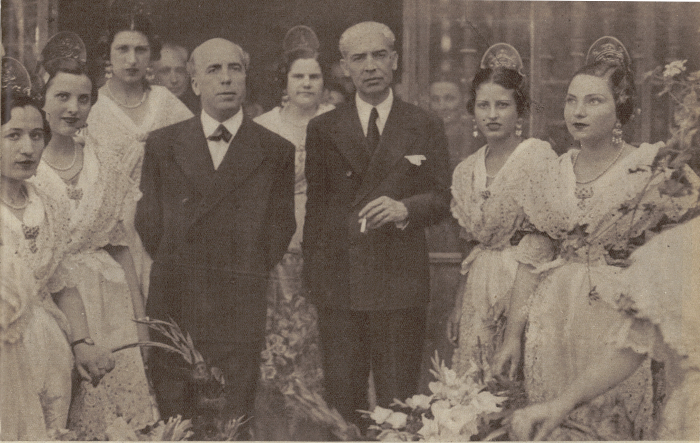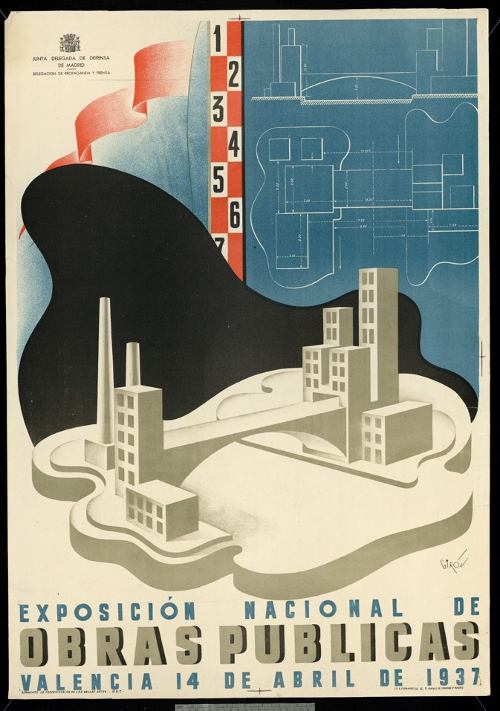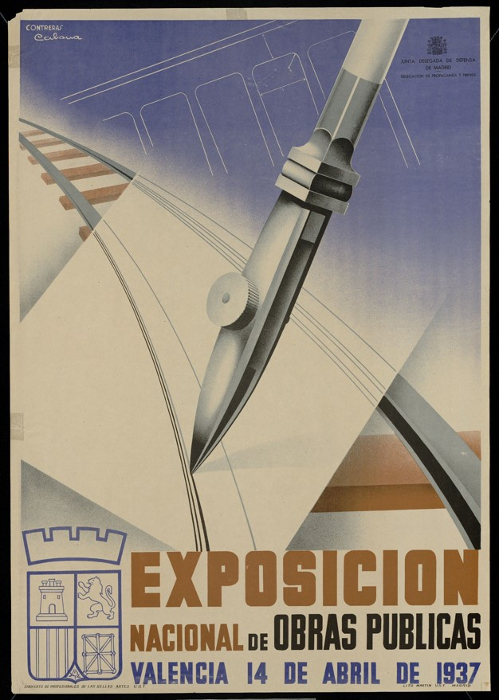
with the attendance of the department minister Giner de los Ríos and his predecessor Julio Just
The National Exhibition of Public Works as a scenario of the promotion policies during the 2nd Republic
The celebration of a National Exhibition of Public Works in Valencia was a project of the minister for Public Works, Julio Just, which was being developed since he occupied the position on 4 September 1936.
The exhibition was inaugurated on 11 June 1937 with the presence of the newly appointed minister for public works, Bernardo Giner de los Ríos, government and Valencian authorities, and the promoter of the exhibition Julio Just, who had just left his position on 17 May.
Different circumstances prevented the inauguration to take place on 14 April, as the magnificent posters of the exhibition say. Its closure also came forward on 16 June. Nevertheless in those six days it was possible to contemplate models, plans, projects, photographs, etc., of the works made during the Republic and in particular in the period of war.

the Delegated Defence Committee of Madrid. Advertising and Press Delegation, Litografía E. Fernández, UGT, Madrid, 1937.
Spain, Ministry of Education, Culture and Sport. Documentation Centre for Historical Memory, Armero, Carteles, 328
It collected the plans and works made to that moment in different branches of engineering, with emphasis on the National Hydraulic Works Plan approved in 1933, which characterised the Ministry's policy.
In a context of war the exhibition assumed a dual purpose: on the one hand, to continue spreading the work of the ministry in a difficult year, emphasizing faith in victory; and, on the other hand, to assist in the activity of international propaganda by a legitimate Government, taking advantage of the fact that ambassadors visited Valencia to deal with issues such as non-intervention.
The war had hindered an exhibition scheduled for January - February 1937.
Finally it was programmed as another act within those that were destined to celebrate the sixth anniversary of the Republic on 14 April, as the magnificent posters of the exhibition say. Its closure also came forward on 16 June.

14 April 1937, edited by the Delegated Defence Committee of Madrid. Advertising and Press Delegation, Martín Litography, UGT,
Madrid, 1937, 100 x 70 cm. Spain, Ministry of Education, Culture and Sport.
Documentation Centre for Historical Memory, Armero, Carteles, 323
The National Programme of Hydraulic Works, approved in 1933, was a subject of discussions, publications and expositions.
Shortly after its approval, it was inaugurated on 8 February 1934 ─the anniversary of Joaquín Costa’s death─ the Graphic Exhibition of the National Programme of Hydraulic Works in the basements of the Music Palace of Madrid.
In June 1937 in the Ancient Silk Market of Valencia, capital of the Republic, and in a very difficult situation ─Madrid’s siege, Bilbao’s fall, anarcho-syndicalist revolution in Barcelona─, most of the exhibition of 1934 was being recreated, this time counting with several mock-ups along with another kind of public works.
Both exhibitions were conceived in a truly modern ─lighting study─ and didactic way. Graphs, canvas, statistics and maps. Those were the protagonists of the exhibitions that convinced the population and engineers of the progress that the Programme would bring. Furthermore, already in 1937, they were all about having an international resonance in one of the many attempts to break the pact of non-intervention. Through the creation of a legitimate Government that carried out with their modernisation and reconstruction plans, establishing an unquestionable bond between the peaceful and the warring Republic that freed itself from revolutionary and ground-breaking visions.
The advertising effort was huge in the Summer of 1937 ─ apart from the writers congress and the exhibition about public works that took place in the Ancient Silk Market, the Republican Government was in the International Exhibition of Paris in 1937, whose pavilion was opened in July 1937.
Through the photomontages, the situation of the Spanish Republic at war was exposed: education, health care, economy, public works. The Exhibition about public works celebrated in Valencia was initially planned to move to Paris, but it never did.

edited by the Delegated Defence Committee of Madrid, Advertising and Press Delegation, Rivadeneyra CO, Madrid, [1937] -.
Female head with its mural crown. Allegory for the Republic.
Spain, Ministry of Education, Culture and Sport. Documentation Centre for Historical Memory, Armero, Carteles, 323











